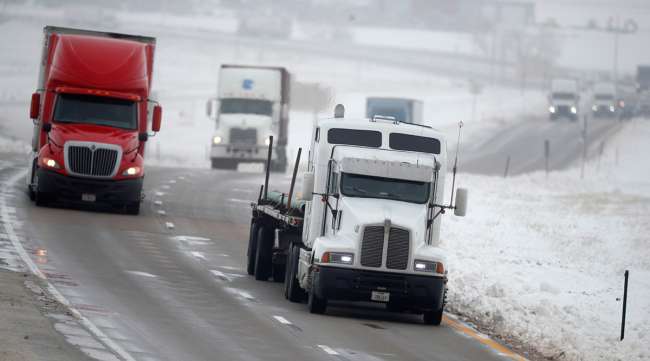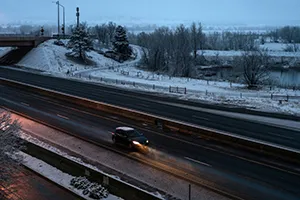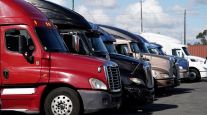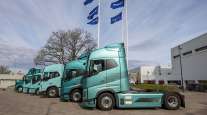The Denver Post
Colorado to Put More Electric Trucks, Semitrailers on Roads

[Stay on top of transportation news: Get TTNews in your inbox.]
Colorado’s trucking industry will need to start investing in zero-emission semitrailers, buses and delivery trucks as soon as 2027 as part of the state’s strategy to reduce greenhouse gas emissions, the cause of climate change.
The Colorado Air Quality Control Commission on April 21 approved a plan to convert most of the medium- and heavy-duty trucks sold in the state to electric vehicles or vehicles that run off of hydrogen fuel cells, starting in 2027, with a goal to have 40% of all semitrailers sold running on zero-emission engines by 2035.
The plan, which is modeled after a rule created in 2020 in California, does not require companies to buy these trucks, but instead orders truck manufacturers to sell the vehicles.
“The manufacturers are required to make sure they meet a certain percentage of sales targets so it will encourage them to bring their vehicles to Colorado and provide attractive pricing for those vehicles,” said Will Toor, executive director of the Colorado Energy Office.
The new rule also requires companies that operate diesel- or natural-gas-powered trucks to move toward lowered nitrogen oxide emissions. Those emissions are a precursor to ozone pollution.
The plan was unanimously approved after nearly three days of hearings last week and it had support from elected officials as well as environmental organizations and community groups, who said the new rule would improve air quality, especially for communities that are adjacent to the three major interstates that run through Colorado.
The new rule received some opposition from those who expressed concern that the utility grid will not be powerful enough to support thousands of semitrailers that need to be charged daily. Others expressed concern that technology won’t be developed fast enough to support the requirement, while some worried about independent truck drivers’ ability to invest in electric vehicles.

Mike Furst of Volvo Trucks North America discusses a dealer-managed service plan that is paired with enhanced connectivity to cover all fleet preventative maintenance. Hear the program above and at RoadSigns.TTNews.com.
And Weld County officials opposed the rule because they wanted vehicles powered by natural gas included in the plan.
Air Pollution Reduction Efforts
But Colorado regulators are in a hurry to reduce air pollution in the state after the Environmental Protection Agency in September reclassified the state’s air quality as being in “severe non-attainment” of federal ozone standards. That designation comes with expensive penalties for private industry and consumers, such as more stringent permitting and higher gas prices during the summer.
Medium- and heavy-duty trucks emit nitrogen oxides and particular matter, compounds that contribute to ozone pollution on hot days, and cars and trucks are the second-largest sources of greenhouse gas emissions in the state, Garry Kaufman, director of the Colorado Department of Public Health and Environment’s regulatory affairs program, said during a presentation on the new rule.
On high ozone days, the thick smog blankets much of the Front Range, causing respiratory problems for people working or exercising outdoors and reducing visibility of Colorado’s majestic mountains.
While the Front Range is mandated by the EPA to reduce its ozone pollution, people living in mountain communities also supported the move, saying a haze often lingers there, too.
“It’s not just about heavy powder days or big raft days,” Glenwood Springs Mayor Jonathan Godes testified during a public hearing. “It’s about the health of our entire city.”

A car drives along U.S. Highway 36 during a winter storm in Boulder, Colo. (Chet Strange/Bloomberg News)
The new plan requires auto manufacturers to produce a specified number of zero-emission medium- and heavy-duty trucks to sell in Colorado, starting with 2027 models. Trucks that run on electric batteries and fuel cells will count as zero-emission vehicles, and companies will get partial credit for hybrid vehicles.
Federal and state tax credits are available to help companies offset the cost of buying zero-emission vehicles.
The percentage of zero-emission trucks that need to be on the roads increases each year through 2035, and the goals vary for pickup trucks and vans, delivery trucks and semitrailers.
When questioned about whether there would be enough inventory to meet the demand for zero-emission trucks, Kaufman told the Air Quality Control Commission that manufacturers are heading in that direction and he believed there would be.
“It’s not science fiction technology,” Kaufman said. “It’s happening now.”
Trucking’s Power Grid Concerns
The Colorado Motor Carriers Association said it supports a transition to zero-emission vehicles, but did not back Colorado’s plan.
Representatives from the association were not available for an interview April 24, but the group presented a rebuttal to the state plan during last week’s hearing. The organization argued that Colorado has not invested enough money into the transition and that the state’s infrastructure will not be able to support electric semitrailers.
It could take up to 1 megawatt — enough to power 350 homes — to fully charge a semitrailer, and it could take eight hours of charging to power up a truck to drive 350 miles, the motor carriers’ rebuttal said.
“As more electric trucks hit the road, the projected power needs for a big truck stop by 2035 will equal that of a small town,” the group said in its document, which cited a study by the utility company National Grid Plc. “In that study, they further identified that a connection to the grid that can handle more than 5 megawatts may take up to eight years to build, at a cost of tens of millions of dollars. Without some tremendous power upgrades to the grid, the transition to electric trucks will be constrained by a grid unprepared for the demand.”
It’s not just about heavy powder days or big raft days... It’s about the health of our entire city.
Jonathan Godes, Mayor of Glenwood Springs, Colo.
Image
But Toor said the threats of power grid failure are exaggerated. The state Legislature years ago ordered utility companies to begin preparing for a switch to electric vehicles and there’s enough capacity to handle it, he said.
Plus, the urgency for reducing greenhouse gas emissions and ozone pollution is strong for the air quality commission. And the amount of support for the move far outweighed opposition during the hearing.
Electrifying trucks and vans will benefit public health, said Jacob Smith, executive director of Colorado Communities for Climate Action. As the transition to zero-emission trucks occurs, air pollution levels are expected to drop in areas where people live along highways and near warehouses and trucking distribution centers.
“It’s a big deal from an equity perspective,” Smith said. “A lot of vulnerable communities also happen to be in close proximity to highways, manufacturing and distribution centers.”
— Denver Post staff writer Judith Kohler contributed to this story.
Want more news? Listen to today's daily briefing below or go here for more info:
Distributed by Tribune Content Agency, LLC





